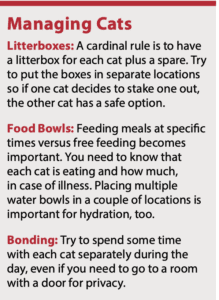We all love photos showing a group of happy, lounging cats, each in their own patch of sunshine. We also know homes with two cats where it seems that each cat’s goal is to make its roommate’s existence as miserable as possible. Still, many families have two or more cats with minimal problems. There are cats who are happiest as solo pets. Most families find a happy medium.
Happy Cats
“One cat is a happy cat. The more cats you have the less likely you are to be bitten, but, of course, inter-cat and house-soiling problems can develop. Many owners note that even in households where there was no apparent problem between cats, after the loss of one cat, the remaining cat became much more friendly and personable,” says Katherine A. Houpt, VMD, PhD, James Law Professor Emeritus, section of behavior medicine in the department of clinical sciences at Cornell University’s College of Veterinary Medicine.
Pamela Perry, DVM, PhD, behavior resident and lecturer at the Cornell University’s College of Veterinary Medicine, agrees, saying that with cats, fewer is usually better, but it depends on the individual cat. Some cats are social or have bonded with other cats before joining your family.
Two kittens, especially if different sexes, often become a fabulous pair. As kittens, they will wear each other out, running and playing and, coincidentally, saving you from scratches and play bites. Such pairs often cuddle together to sleep and have a positive coexistence.
If you choose to add two adult cats, do try to get different sexes. Adding both at the same time can help minimize territorial struggles. Once you get beyond two, things can get trickier. Dr. Perry’s experience suggests that males are less likely to fight but more likely to spray, however, the number of cats may be more important than their gender distribution.
Adding a Cat
Adding a new cat can be a challenge, but you can smooth out the introductions. Start by putting the new cat in a separate room, complete with litterbox, toys, beds, food bowls, and water bowls. Initially, a solid door is ideal.
“Gradual introductions, especially with cats, are important,” says Dr. Perry. “Isolate the newcomer in a room and exchange odors/pheromones to help familiarize the cats with each other’s scent. To do so, rub each cat’s cheek/facial area with a separate cloth and give it to the other cat to investigate (but watch for signs of fear or aggression).” The ideal reaction would be ignoring the scent cloth or mild interest.
The next step is to use baby gates to separate the cats. Remember cats climb, so these need to go up to the top of the doorway. Now the cats can see each other as well as smell and hear the newcomer. If your resident cat has favorite treats, this is a good time to dispense some to both cats at the doorway. You want your homeboy feline to associate the newcomer with good things.
 You can start the feeding with the closed door as an alternative method. “The cats can also be counter conditioned to each other by feeding them on opposite sides of the closed door that separates them. Once both cats can eat without fear or aggression, introduce them carefully for five to 10 minutes at a time and with both parties restrained. Make sure that all cats have escape areas in case the introduction doesn’t go well,” says Dr. Perry.
You can start the feeding with the closed door as an alternative method. “The cats can also be counter conditioned to each other by feeding them on opposite sides of the closed door that separates them. Once both cats can eat without fear or aggression, introduce them carefully for five to 10 minutes at a time and with both parties restrained. Make sure that all cats have escape areas in case the introduction doesn’t go well,” says Dr. Perry.
Putting one cat in a crate in a room with the other one loose for short periods of time also can work. Both cats can then see and smell each other, but they can’t interact too closely.
During these introductory times, plan to use a Feliway dispenser in the area to help encourage calm behavior. Once the cats are together, Feliway-sprayed bandanas may help to keep things under control. If both cats react to catnip by mellowing out, spreading some catnip in the room can also help introductions.
Having more than one cat can be challenging, but more cats can also provide plenty of extra love to the family and to the cats themselves.
 Katherine A. Houpt, VMD, PhD, is a James Law Professor Emeritus, section of behavior medicine in clinical sciences at Cornell University’s College of Veterinary Medicine.
Katherine A. Houpt, VMD, PhD, is a James Law Professor Emeritus, section of behavior medicine in clinical sciences at Cornell University’s College of Veterinary Medicine.
 Pamela Perry, DVM, PhD, is a behavior resident and lecturer at the Cornell University’s College of Veterinary Medicine.
Pamela Perry, DVM, PhD, is a behavior resident and lecturer at the Cornell University’s College of Veterinary Medicine.




